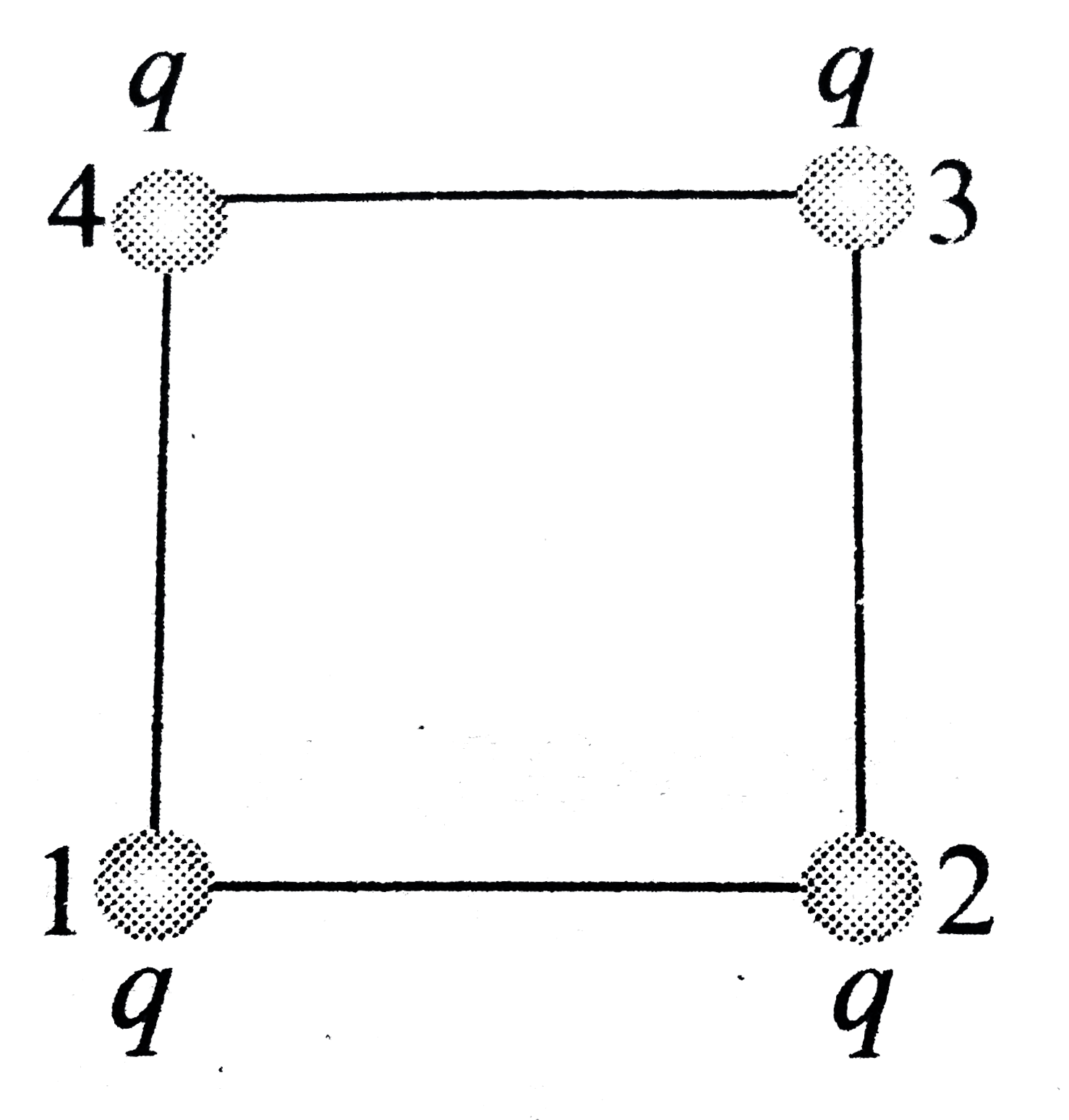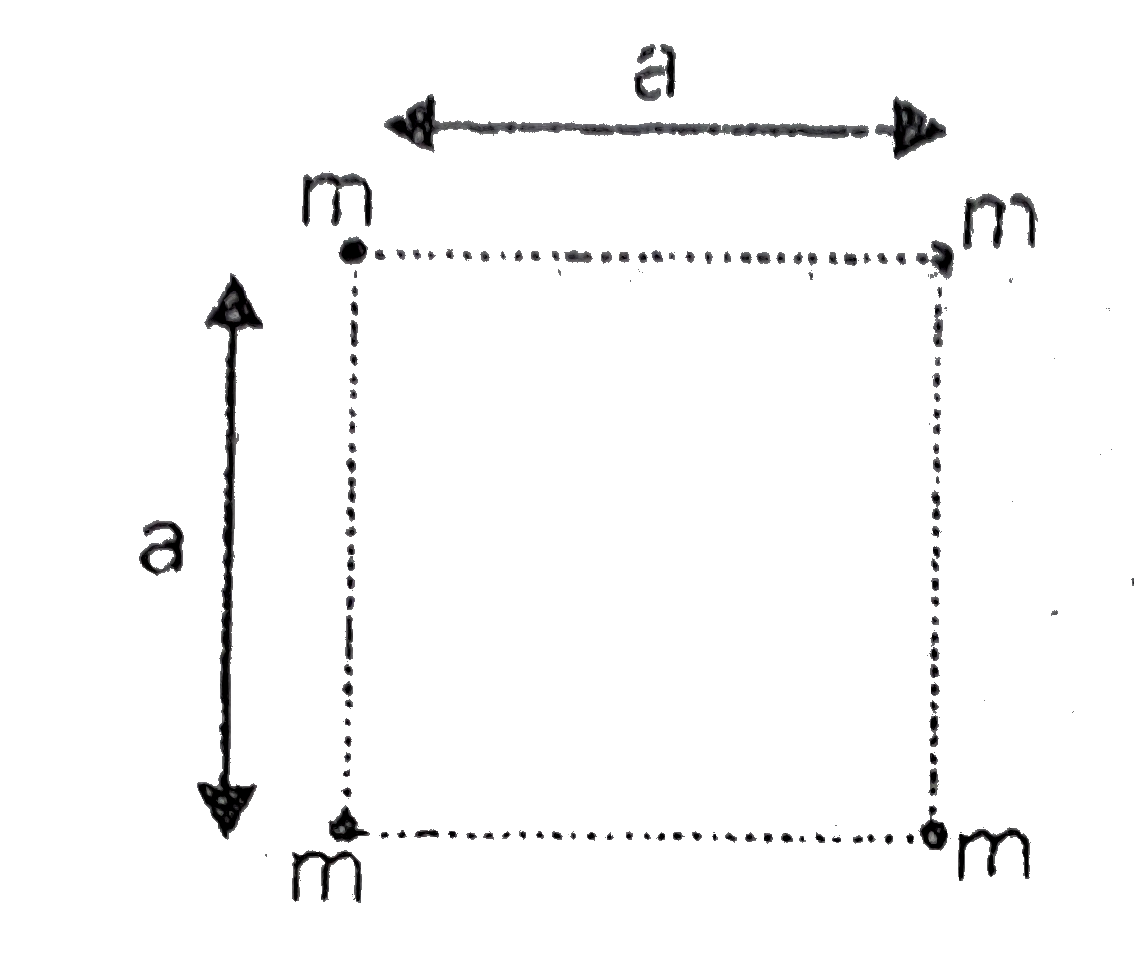The force between two identical particles separated by distance d is F . Four such identical particles are placed at the corners of a square of side d. The magnitude of net force on any particle will be
Zero
(2√2+1)F
(2√2+1)F2
(2√2−1)F2
To find the net force on any particle placed at the corners of a square formed by four identical particles, we can follow these steps:
Step 1: Understand the Configuration
We have four identical particles placed at the corners of a square with side length d. Let's label the particles as A,B,C, and D.
Step 2: Identify the Forces Acting on One Particle
Let's consider the force acting on particle A. The forces acting on particle A are due to particles B (to the right), D (below), and C (diagonally opposite).
Step 3: Calculate the Forces Between the Particles
The force between any two particles separated by distance d is given as F. Therefore:
- The force between A and B is F (to the right).
- The force between A and D is F (downward).
- The force between A and C is also F, but since C is diagonally opposite, the distance between A and C is √d2+d2=d√2.
Step 4: Calculate the Force Between A and C
Using the inverse square law, the force between A and C can be calculated as:
FAC=F2(since the distance is d√2)
Step 5: Resolve the Forces into Components
Now, we need to resolve the forces acting on A:
- The force FAB (to the right) has components:
- FABx=F
- FABy=0
- The force FAD (downward) has components:
- FADx=0
- FADy=F
- The force FAC (diagonal) can be resolved into components:
- FACx=F2⋅cos(45∘)=F2√2
- FACy=F2⋅sin(45∘)=F2√2
Step 6: Calculate the Net Force Components
Now, we can sum the components:
- In the x-direction:
Fnetx=F+F2√2
- In the y-direction:
Fnety=F+F2√2
Step 7: Calculate the Magnitude of the Net Force
The magnitude of the net force Fnet can be calculated using the Pythagorean theorem:
Fnet=√(F+F2√2)2+(F+F2√2)2
Step 8: Simplify the Expression
This simplifies to:
Fnet=
⎷2(F+F2√2)2
Fnet=√2(F+F2√2)
Final Result
Thus, the magnitude of the net force on any particle is:
Fnet=F(√2+1√2)=F(3√2)
We have four identical particles placed at the corners of a square with side length d. Let's label the particles as A,B,C, and D.
Let's consider the force acting on particle A. The forces acting on particle A are due to particles B (to the right), D (below), and C (diagonally opposite).
The force between any two particles separated by distance d is given as F. Therefore:
- The force between A and B is F (to the right).
- The force between A and D is F (downward).
- The force between A and C is also F, but since C is diagonally opposite, the distance between A and C is √d2+d2=d√2.
Using the inverse square law, the force between A and C can be calculated as:
FAC=F2(since the distance is d√2)
Now, we need to resolve the forces acting on A:
- The force FAB (to the right) has components:
- FABx=F
- FABy=0
- The force FAD (downward) has components:
- FADx=0
- FADy=F
- FACx=F2⋅cos(45∘)=F2√2
- FACy=F2⋅sin(45∘)=F2√2
Now, we can sum the components:
- In the x-direction:
Fnetx=F+F2√2
- In the y-direction:
Fnety=F+F2√2
The magnitude of the net force Fnet can be calculated using the Pythagorean theorem:
Fnet=√(F+F2√2)2+(F+F2√2)2
This simplifies to:
Fnet=
⎷2(F+F2√2)2
Fnet=√2(F+F2√2)
Thus, the magnitude of the net force on any particle is:
Fnet=F(√2+1√2)=F(3√2)
Topper's Solved these Questions
Similar Questions
Knowledge Check
Equal charges q are placed at the four corners A,B,C,Dof a square of length a. The magnitude of the force on the charge at B will be
A3q24πε0a2B4q24πε0a2C(1+2√22)q24πε0a2D(2+1√2)q24πε0a2Equal charges Q are placed at the four corners A, B, C, D of a square of length a. The magnitude of the force on the charge at B will be
A3Q24πε0a2B4Q24πε0a2C(1+1√22)Q24πε0a2D(2+1√2)Q24πε0a2The gravitational force between two particles separated by a distance r varies as ……………
A1rBrCr2D1r2
Four identical point charges q are placed at four corners of a square of side a. Find the potential energy of the charge system.
 .
.
View SolutionThe force between two alpha particles separated by a distance 'r' is F. In order to have same force the distance between single ionized chlorine atoms separated by a distance of
View SolutionThe gravitational force between two particles separated by a distance r varies as ……………
View SolutionThe force between an α-particle and an electron separated by a distance of 1Å is -
View SolutionA particle is simultaneously acted by two forces equal to 4N and 3N. The net force on the particle is
View Solution

 .
.